University Assignment: Design Thinking and Airbnb Case Study
VerifiedAdded on 2021/06/17
|11
|2907
|20
Case Study
AI Summary
This case study delves into the application of design thinking by Airbnb, tracing its evolution from a struggling startup to a global hospitality giant. It examines the company's origins, its challenges, and the pivotal role of design thinking in its turnaround. The paper highlights Airbnb's core business model, emphasizing its focus on user experience, trust-building mechanisms, and community engagement. It further analyzes the company's operational strategies, including its website functionalities, host-guest interactions, and payment systems. The study emphasizes key factors contributing to Airbnb's success, such as connecting travelers with hosts, providing alternative accommodation options, and leveraging social networks. It also explores the challenges faced by Airbnb and the company's innovative approach to address them. Overall, the case study provides a comprehensive overview of how design thinking principles have shaped Airbnb's business model and contributed to its remarkable growth in the sharing economy.
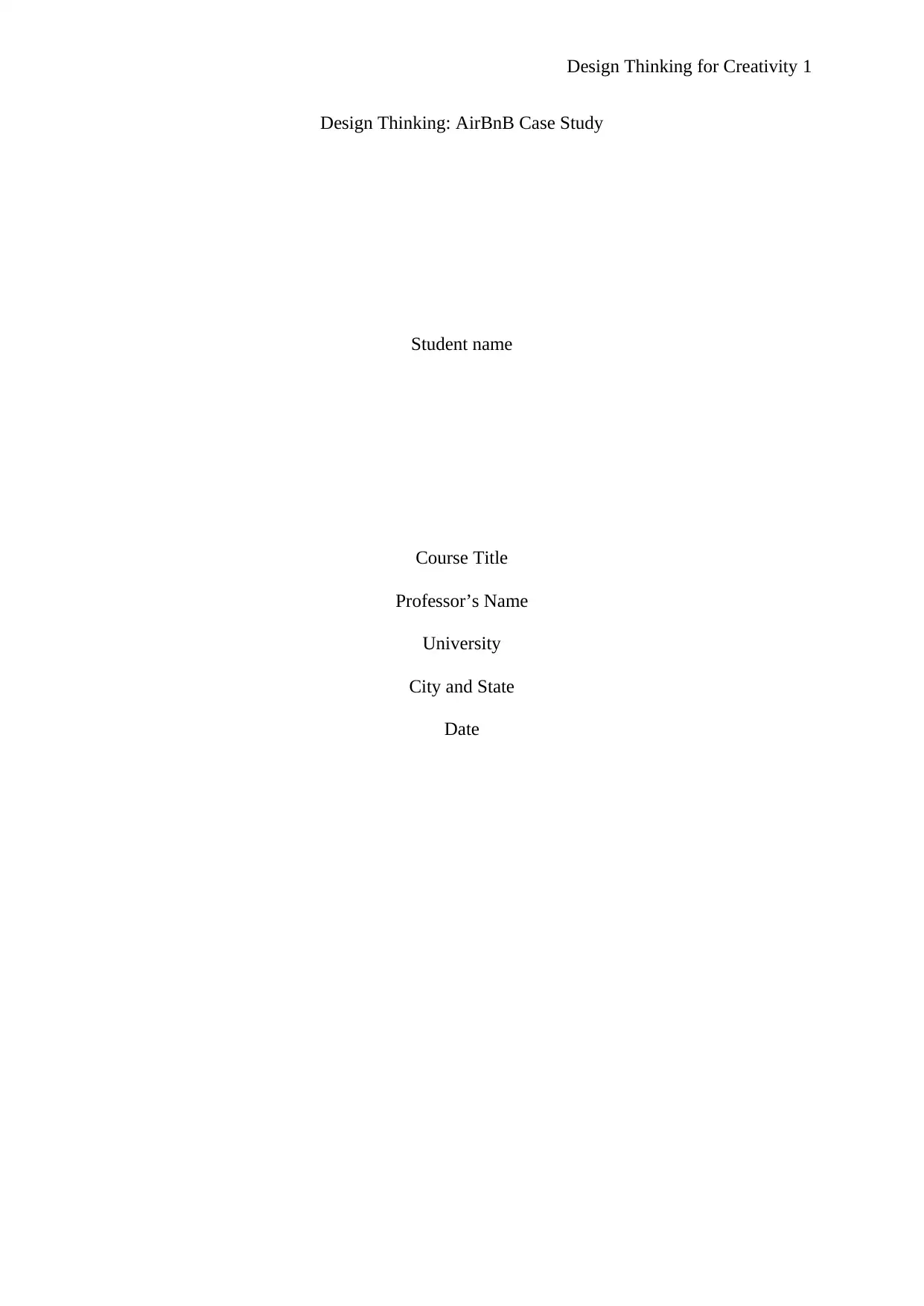
Design Thinking for Creativity 1
Design Thinking: AirBnB Case Study
Student name
Course Title
Professor’s Name
University
City and State
Date
Design Thinking: AirBnB Case Study
Student name
Course Title
Professor’s Name
University
City and State
Date
Paraphrase This Document
Need a fresh take? Get an instant paraphrase of this document with our AI Paraphraser
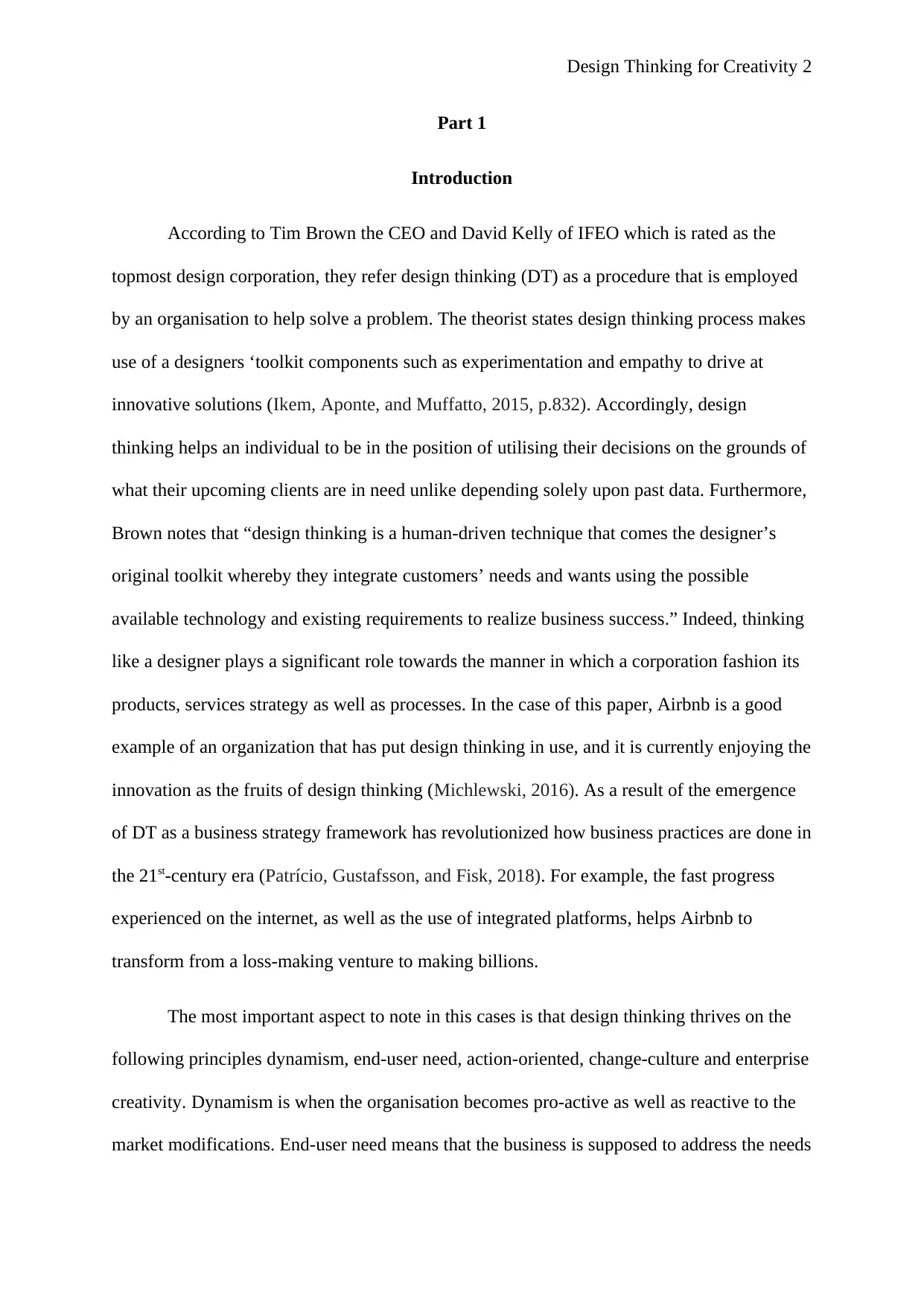
Design Thinking for Creativity 2
Part 1
Introduction
According to Tim Brown the CEO and David Kelly of IFEO which is rated as the
topmost design corporation, they refer design thinking (DT) as a procedure that is employed
by an organisation to help solve a problem. The theorist states design thinking process makes
use of a designers ‘toolkit components such as experimentation and empathy to drive at
innovative solutions (Ikem, Aponte, and Muffatto, 2015, p.832). Accordingly, design
thinking helps an individual to be in the position of utilising their decisions on the grounds of
what their upcoming clients are in need unlike depending solely upon past data. Furthermore,
Brown notes that “design thinking is a human-driven technique that comes the designer’s
original toolkit whereby they integrate customers’ needs and wants using the possible
available technology and existing requirements to realize business success.” Indeed, thinking
like a designer plays a significant role towards the manner in which a corporation fashion its
products, services strategy as well as processes. In the case of this paper, Airbnb is a good
example of an organization that has put design thinking in use, and it is currently enjoying the
innovation as the fruits of design thinking (Michlewski, 2016). As a result of the emergence
of DT as a business strategy framework has revolutionized how business practices are done in
the 21st-century era (Patrício, Gustafsson, and Fisk, 2018). For example, the fast progress
experienced on the internet, as well as the use of integrated platforms, helps Airbnb to
transform from a loss-making venture to making billions.
The most important aspect to note in this cases is that design thinking thrives on the
following principles dynamism, end-user need, action-oriented, change-culture and enterprise
creativity. Dynamism is when the organisation becomes pro-active as well as reactive to the
market modifications. End-user need means that the business is supposed to address the needs
Part 1
Introduction
According to Tim Brown the CEO and David Kelly of IFEO which is rated as the
topmost design corporation, they refer design thinking (DT) as a procedure that is employed
by an organisation to help solve a problem. The theorist states design thinking process makes
use of a designers ‘toolkit components such as experimentation and empathy to drive at
innovative solutions (Ikem, Aponte, and Muffatto, 2015, p.832). Accordingly, design
thinking helps an individual to be in the position of utilising their decisions on the grounds of
what their upcoming clients are in need unlike depending solely upon past data. Furthermore,
Brown notes that “design thinking is a human-driven technique that comes the designer’s
original toolkit whereby they integrate customers’ needs and wants using the possible
available technology and existing requirements to realize business success.” Indeed, thinking
like a designer plays a significant role towards the manner in which a corporation fashion its
products, services strategy as well as processes. In the case of this paper, Airbnb is a good
example of an organization that has put design thinking in use, and it is currently enjoying the
innovation as the fruits of design thinking (Michlewski, 2016). As a result of the emergence
of DT as a business strategy framework has revolutionized how business practices are done in
the 21st-century era (Patrício, Gustafsson, and Fisk, 2018). For example, the fast progress
experienced on the internet, as well as the use of integrated platforms, helps Airbnb to
transform from a loss-making venture to making billions.
The most important aspect to note in this cases is that design thinking thrives on the
following principles dynamism, end-user need, action-oriented, change-culture and enterprise
creativity. Dynamism is when the organisation becomes pro-active as well as reactive to the
market modifications. End-user need means that the business is supposed to address the needs
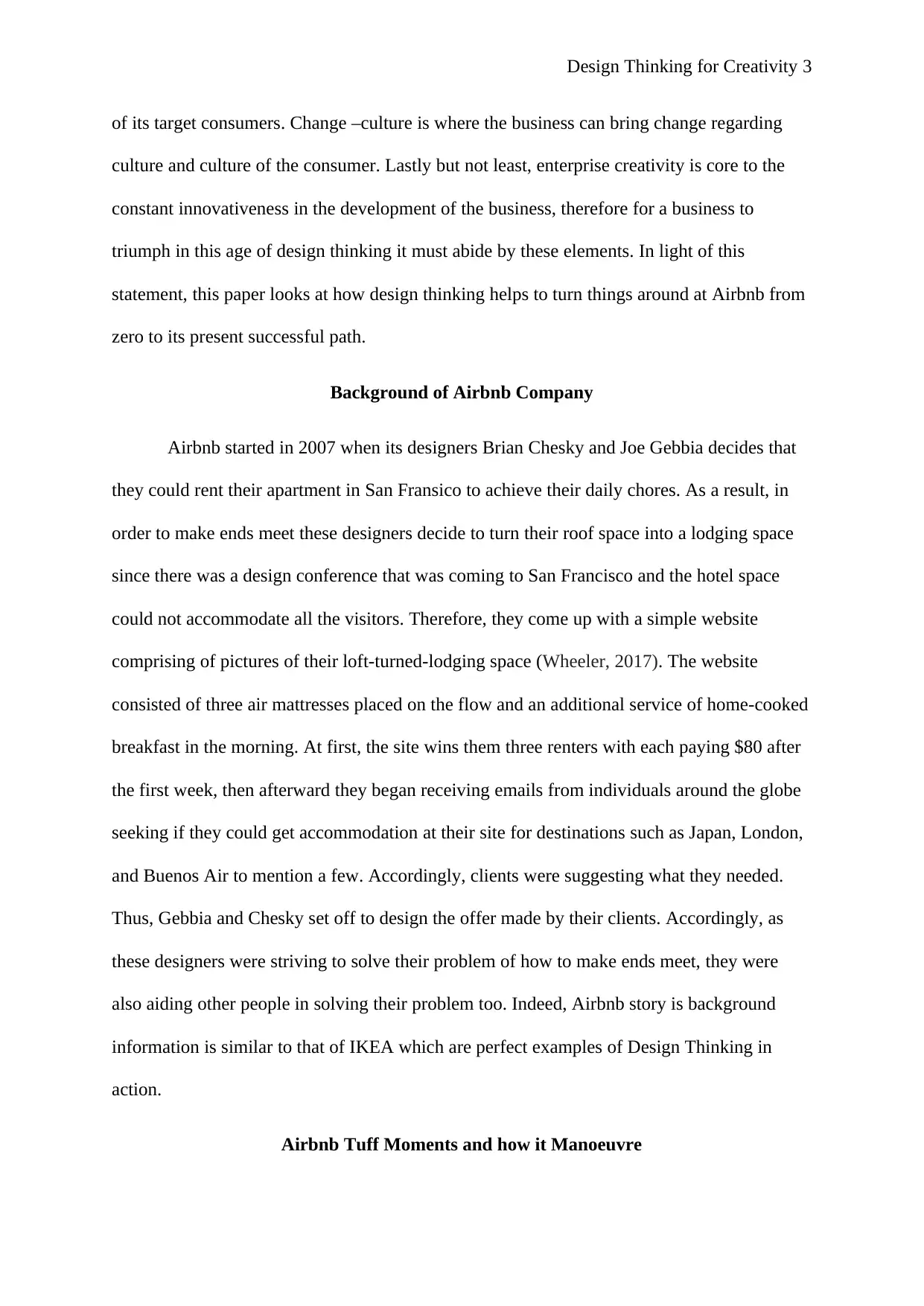
Design Thinking for Creativity 3
of its target consumers. Change –culture is where the business can bring change regarding
culture and culture of the consumer. Lastly but not least, enterprise creativity is core to the
constant innovativeness in the development of the business, therefore for a business to
triumph in this age of design thinking it must abide by these elements. In light of this
statement, this paper looks at how design thinking helps to turn things around at Airbnb from
zero to its present successful path.
Background of Airbnb Company
Airbnb started in 2007 when its designers Brian Chesky and Joe Gebbia decides that
they could rent their apartment in San Fransico to achieve their daily chores. As a result, in
order to make ends meet these designers decide to turn their roof space into a lodging space
since there was a design conference that was coming to San Francisco and the hotel space
could not accommodate all the visitors. Therefore, they come up with a simple website
comprising of pictures of their loft-turned-lodging space (Wheeler, 2017). The website
consisted of three air mattresses placed on the flow and an additional service of home-cooked
breakfast in the morning. At first, the site wins them three renters with each paying $80 after
the first week, then afterward they began receiving emails from individuals around the globe
seeking if they could get accommodation at their site for destinations such as Japan, London,
and Buenos Air to mention a few. Accordingly, clients were suggesting what they needed.
Thus, Gebbia and Chesky set off to design the offer made by their clients. Accordingly, as
these designers were striving to solve their problem of how to make ends meet, they were
also aiding other people in solving their problem too. Indeed, Airbnb story is background
information is similar to that of IKEA which are perfect examples of Design Thinking in
action.
Airbnb Tuff Moments and how it Manoeuvre
of its target consumers. Change –culture is where the business can bring change regarding
culture and culture of the consumer. Lastly but not least, enterprise creativity is core to the
constant innovativeness in the development of the business, therefore for a business to
triumph in this age of design thinking it must abide by these elements. In light of this
statement, this paper looks at how design thinking helps to turn things around at Airbnb from
zero to its present successful path.
Background of Airbnb Company
Airbnb started in 2007 when its designers Brian Chesky and Joe Gebbia decides that
they could rent their apartment in San Fransico to achieve their daily chores. As a result, in
order to make ends meet these designers decide to turn their roof space into a lodging space
since there was a design conference that was coming to San Francisco and the hotel space
could not accommodate all the visitors. Therefore, they come up with a simple website
comprising of pictures of their loft-turned-lodging space (Wheeler, 2017). The website
consisted of three air mattresses placed on the flow and an additional service of home-cooked
breakfast in the morning. At first, the site wins them three renters with each paying $80 after
the first week, then afterward they began receiving emails from individuals around the globe
seeking if they could get accommodation at their site for destinations such as Japan, London,
and Buenos Air to mention a few. Accordingly, clients were suggesting what they needed.
Thus, Gebbia and Chesky set off to design the offer made by their clients. Accordingly, as
these designers were striving to solve their problem of how to make ends meet, they were
also aiding other people in solving their problem too. Indeed, Airbnb story is background
information is similar to that of IKEA which are perfect examples of Design Thinking in
action.
Airbnb Tuff Moments and how it Manoeuvre
⊘ This is a preview!⊘
Do you want full access?
Subscribe today to unlock all pages.

Trusted by 1+ million students worldwide
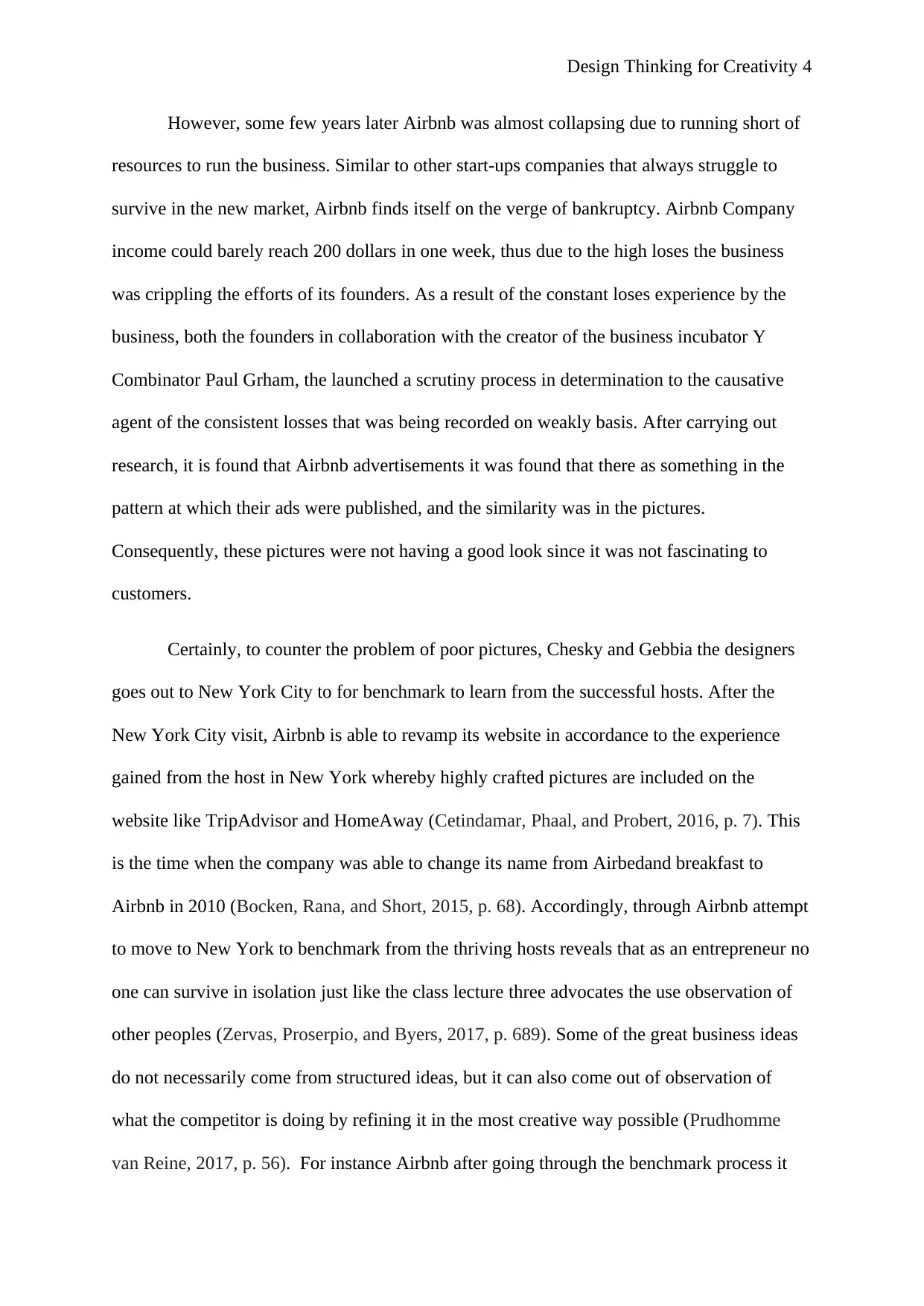
Design Thinking for Creativity 4
However, some few years later Airbnb was almost collapsing due to running short of
resources to run the business. Similar to other start-ups companies that always struggle to
survive in the new market, Airbnb finds itself on the verge of bankruptcy. Airbnb Company
income could barely reach 200 dollars in one week, thus due to the high loses the business
was crippling the efforts of its founders. As a result of the constant loses experience by the
business, both the founders in collaboration with the creator of the business incubator Y
Combinator Paul Grham, the launched a scrutiny process in determination to the causative
agent of the consistent losses that was being recorded on weakly basis. After carrying out
research, it is found that Airbnb advertisements it was found that there as something in the
pattern at which their ads were published, and the similarity was in the pictures.
Consequently, these pictures were not having a good look since it was not fascinating to
customers.
Certainly, to counter the problem of poor pictures, Chesky and Gebbia the designers
goes out to New York City to for benchmark to learn from the successful hosts. After the
New York City visit, Airbnb is able to revamp its website in accordance to the experience
gained from the host in New York whereby highly crafted pictures are included on the
website like TripAdvisor and HomeAway (Cetindamar, Phaal, and Probert, 2016, p. 7). This
is the time when the company was able to change its name from Airbedand breakfast to
Airbnb in 2010 (Bocken, Rana, and Short, 2015, p. 68). Accordingly, through Airbnb attempt
to move to New York to benchmark from the thriving hosts reveals that as an entrepreneur no
one can survive in isolation just like the class lecture three advocates the use observation of
other peoples (Zervas, Proserpio, and Byers, 2017, p. 689). Some of the great business ideas
do not necessarily come from structured ideas, but it can also come out of observation of
what the competitor is doing by refining it in the most creative way possible (Prudhomme
van Reine, 2017, p. 56). For instance Airbnb after going through the benchmark process it
However, some few years later Airbnb was almost collapsing due to running short of
resources to run the business. Similar to other start-ups companies that always struggle to
survive in the new market, Airbnb finds itself on the verge of bankruptcy. Airbnb Company
income could barely reach 200 dollars in one week, thus due to the high loses the business
was crippling the efforts of its founders. As a result of the constant loses experience by the
business, both the founders in collaboration with the creator of the business incubator Y
Combinator Paul Grham, the launched a scrutiny process in determination to the causative
agent of the consistent losses that was being recorded on weakly basis. After carrying out
research, it is found that Airbnb advertisements it was found that there as something in the
pattern at which their ads were published, and the similarity was in the pictures.
Consequently, these pictures were not having a good look since it was not fascinating to
customers.
Certainly, to counter the problem of poor pictures, Chesky and Gebbia the designers
goes out to New York City to for benchmark to learn from the successful hosts. After the
New York City visit, Airbnb is able to revamp its website in accordance to the experience
gained from the host in New York whereby highly crafted pictures are included on the
website like TripAdvisor and HomeAway (Cetindamar, Phaal, and Probert, 2016, p. 7). This
is the time when the company was able to change its name from Airbedand breakfast to
Airbnb in 2010 (Bocken, Rana, and Short, 2015, p. 68). Accordingly, through Airbnb attempt
to move to New York to benchmark from the thriving hosts reveals that as an entrepreneur no
one can survive in isolation just like the class lecture three advocates the use observation of
other peoples (Zervas, Proserpio, and Byers, 2017, p. 689). Some of the great business ideas
do not necessarily come from structured ideas, but it can also come out of observation of
what the competitor is doing by refining it in the most creative way possible (Prudhomme
van Reine, 2017, p. 56). For instance Airbnb after going through the benchmark process it
Paraphrase This Document
Need a fresh take? Get an instant paraphrase of this document with our AI Paraphraser
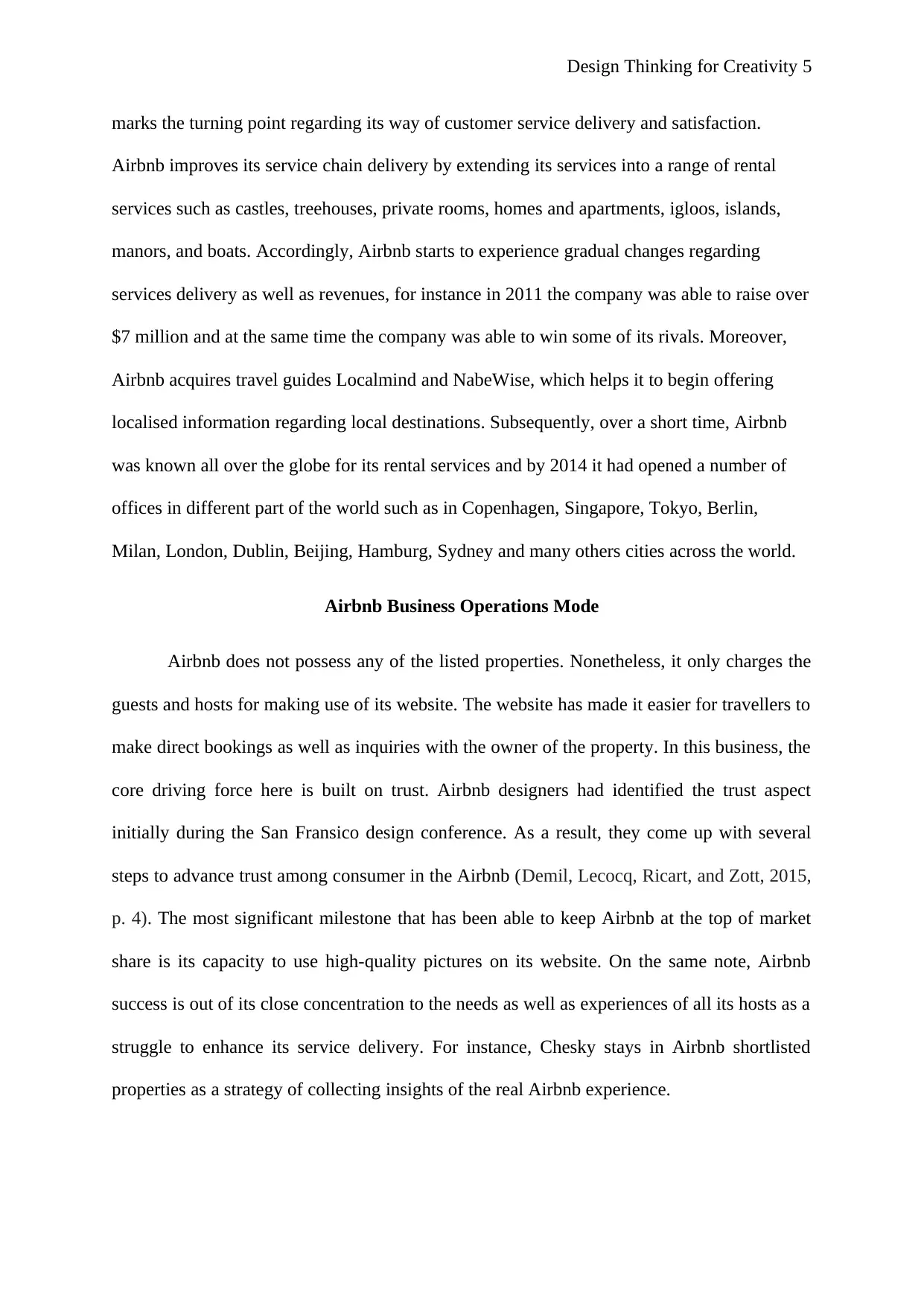
Design Thinking for Creativity 5
marks the turning point regarding its way of customer service delivery and satisfaction.
Airbnb improves its service chain delivery by extending its services into a range of rental
services such as castles, treehouses, private rooms, homes and apartments, igloos, islands,
manors, and boats. Accordingly, Airbnb starts to experience gradual changes regarding
services delivery as well as revenues, for instance in 2011 the company was able to raise over
$7 million and at the same time the company was able to win some of its rivals. Moreover,
Airbnb acquires travel guides Localmind and NabeWise, which helps it to begin offering
localised information regarding local destinations. Subsequently, over a short time, Airbnb
was known all over the globe for its rental services and by 2014 it had opened a number of
offices in different part of the world such as in Copenhagen, Singapore, Tokyo, Berlin,
Milan, London, Dublin, Beijing, Hamburg, Sydney and many others cities across the world.
Airbnb Business Operations Mode
Airbnb does not possess any of the listed properties. Nonetheless, it only charges the
guests and hosts for making use of its website. The website has made it easier for travellers to
make direct bookings as well as inquiries with the owner of the property. In this business, the
core driving force here is built on trust. Airbnb designers had identified the trust aspect
initially during the San Fransico design conference. As a result, they come up with several
steps to advance trust among consumer in the Airbnb (Demil, Lecocq, Ricart, and Zott, 2015,
p. 4). The most significant milestone that has been able to keep Airbnb at the top of market
share is its capacity to use high-quality pictures on its website. On the same note, Airbnb
success is out of its close concentration to the needs as well as experiences of all its hosts as a
struggle to enhance its service delivery. For instance, Chesky stays in Airbnb shortlisted
properties as a strategy of collecting insights of the real Airbnb experience.
marks the turning point regarding its way of customer service delivery and satisfaction.
Airbnb improves its service chain delivery by extending its services into a range of rental
services such as castles, treehouses, private rooms, homes and apartments, igloos, islands,
manors, and boats. Accordingly, Airbnb starts to experience gradual changes regarding
services delivery as well as revenues, for instance in 2011 the company was able to raise over
$7 million and at the same time the company was able to win some of its rivals. Moreover,
Airbnb acquires travel guides Localmind and NabeWise, which helps it to begin offering
localised information regarding local destinations. Subsequently, over a short time, Airbnb
was known all over the globe for its rental services and by 2014 it had opened a number of
offices in different part of the world such as in Copenhagen, Singapore, Tokyo, Berlin,
Milan, London, Dublin, Beijing, Hamburg, Sydney and many others cities across the world.
Airbnb Business Operations Mode
Airbnb does not possess any of the listed properties. Nonetheless, it only charges the
guests and hosts for making use of its website. The website has made it easier for travellers to
make direct bookings as well as inquiries with the owner of the property. In this business, the
core driving force here is built on trust. Airbnb designers had identified the trust aspect
initially during the San Fransico design conference. As a result, they come up with several
steps to advance trust among consumer in the Airbnb (Demil, Lecocq, Ricart, and Zott, 2015,
p. 4). The most significant milestone that has been able to keep Airbnb at the top of market
share is its capacity to use high-quality pictures on its website. On the same note, Airbnb
success is out of its close concentration to the needs as well as experiences of all its hosts as a
struggle to enhance its service delivery. For instance, Chesky stays in Airbnb shortlisted
properties as a strategy of collecting insights of the real Airbnb experience.
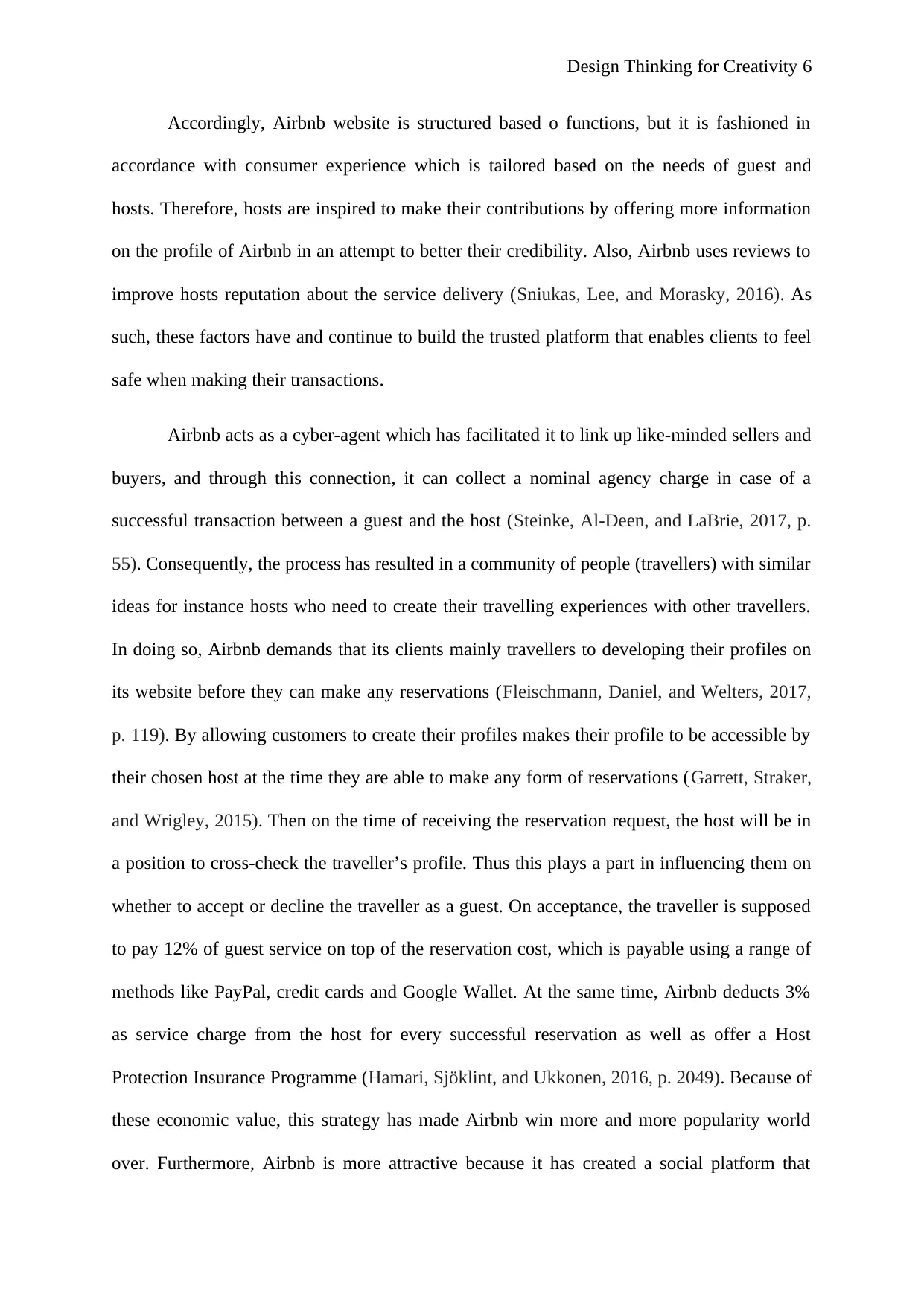
Design Thinking for Creativity 6
Accordingly, Airbnb website is structured based o functions, but it is fashioned in
accordance with consumer experience which is tailored based on the needs of guest and
hosts. Therefore, hosts are inspired to make their contributions by offering more information
on the profile of Airbnb in an attempt to better their credibility. Also, Airbnb uses reviews to
improve hosts reputation about the service delivery (Sniukas, Lee, and Morasky, 2016). As
such, these factors have and continue to build the trusted platform that enables clients to feel
safe when making their transactions.
Airbnb acts as a cyber-agent which has facilitated it to link up like-minded sellers and
buyers, and through this connection, it can collect a nominal agency charge in case of a
successful transaction between a guest and the host (Steinke, Al-Deen, and LaBrie, 2017, p.
55). Consequently, the process has resulted in a community of people (travellers) with similar
ideas for instance hosts who need to create their travelling experiences with other travellers.
In doing so, Airbnb demands that its clients mainly travellers to developing their profiles on
its website before they can make any reservations (Fleischmann, Daniel, and Welters, 2017,
p. 119). By allowing customers to create their profiles makes their profile to be accessible by
their chosen host at the time they are able to make any form of reservations (Garrett, Straker,
and Wrigley, 2015). Then on the time of receiving the reservation request, the host will be in
a position to cross-check the traveller’s profile. Thus this plays a part in influencing them on
whether to accept or decline the traveller as a guest. On acceptance, the traveller is supposed
to pay 12% of guest service on top of the reservation cost, which is payable using a range of
methods like PayPal, credit cards and Google Wallet. At the same time, Airbnb deducts 3%
as service charge from the host for every successful reservation as well as offer a Host
Protection Insurance Programme (Hamari, Sjöklint, and Ukkonen, 2016, p. 2049). Because of
these economic value, this strategy has made Airbnb win more and more popularity world
over. Furthermore, Airbnb is more attractive because it has created a social platform that
Accordingly, Airbnb website is structured based o functions, but it is fashioned in
accordance with consumer experience which is tailored based on the needs of guest and
hosts. Therefore, hosts are inspired to make their contributions by offering more information
on the profile of Airbnb in an attempt to better their credibility. Also, Airbnb uses reviews to
improve hosts reputation about the service delivery (Sniukas, Lee, and Morasky, 2016). As
such, these factors have and continue to build the trusted platform that enables clients to feel
safe when making their transactions.
Airbnb acts as a cyber-agent which has facilitated it to link up like-minded sellers and
buyers, and through this connection, it can collect a nominal agency charge in case of a
successful transaction between a guest and the host (Steinke, Al-Deen, and LaBrie, 2017, p.
55). Consequently, the process has resulted in a community of people (travellers) with similar
ideas for instance hosts who need to create their travelling experiences with other travellers.
In doing so, Airbnb demands that its clients mainly travellers to developing their profiles on
its website before they can make any reservations (Fleischmann, Daniel, and Welters, 2017,
p. 119). By allowing customers to create their profiles makes their profile to be accessible by
their chosen host at the time they are able to make any form of reservations (Garrett, Straker,
and Wrigley, 2015). Then on the time of receiving the reservation request, the host will be in
a position to cross-check the traveller’s profile. Thus this plays a part in influencing them on
whether to accept or decline the traveller as a guest. On acceptance, the traveller is supposed
to pay 12% of guest service on top of the reservation cost, which is payable using a range of
methods like PayPal, credit cards and Google Wallet. At the same time, Airbnb deducts 3%
as service charge from the host for every successful reservation as well as offer a Host
Protection Insurance Programme (Hamari, Sjöklint, and Ukkonen, 2016, p. 2049). Because of
these economic value, this strategy has made Airbnb win more and more popularity world
over. Furthermore, Airbnb is more attractive because it has created a social platform that
⊘ This is a preview!⊘
Do you want full access?
Subscribe today to unlock all pages.

Trusted by 1+ million students worldwide
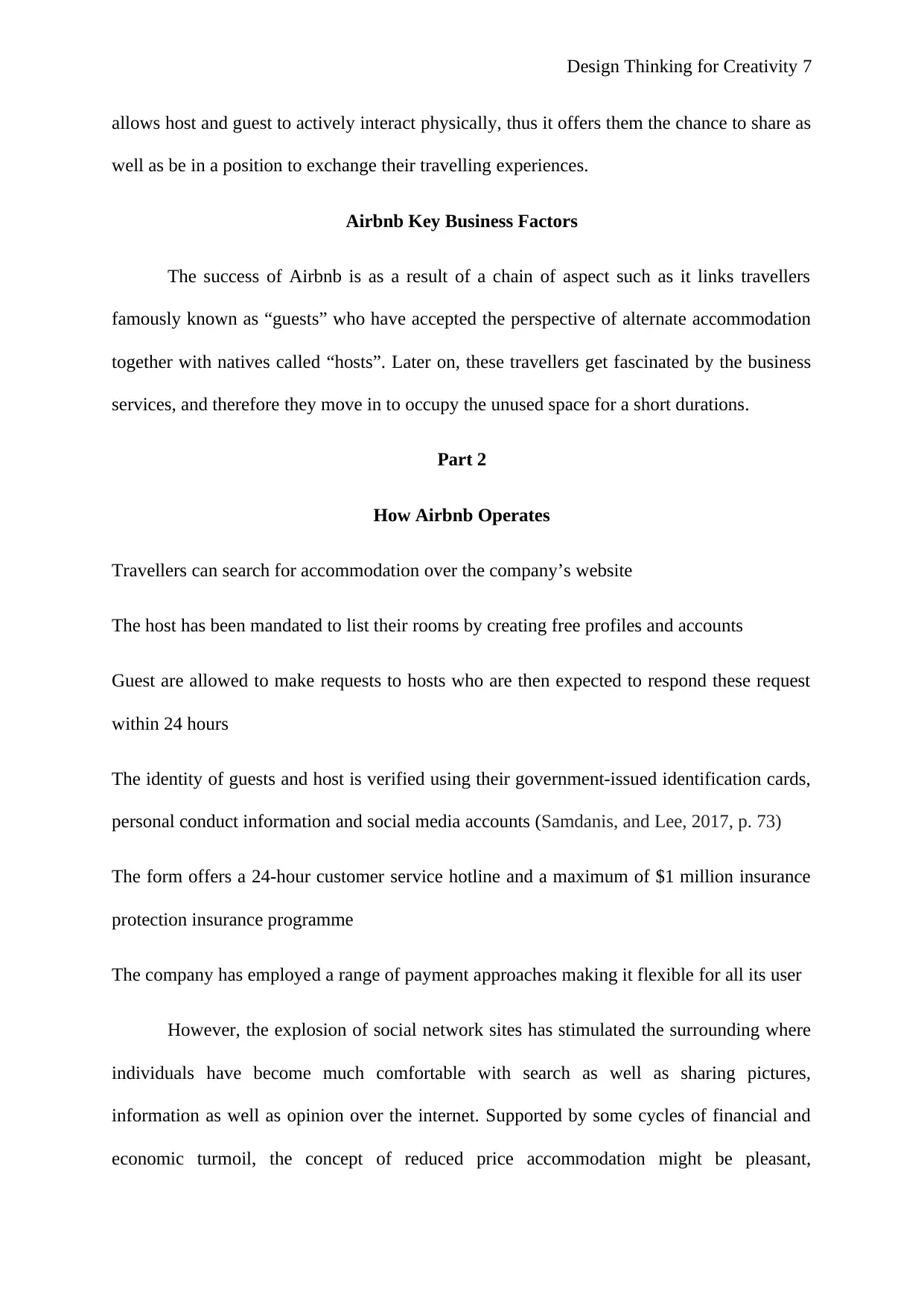
Design Thinking for Creativity 7
allows host and guest to actively interact physically, thus it offers them the chance to share as
well as be in a position to exchange their travelling experiences.
Airbnb Key Business Factors
The success of Airbnb is as a result of a chain of aspect such as it links travellers
famously known as “guests” who have accepted the perspective of alternate accommodation
together with natives called “hosts”. Later on, these travellers get fascinated by the business
services, and therefore they move in to occupy the unused space for a short durations.
Part 2
How Airbnb Operates
Travellers can search for accommodation over the company’s website
The host has been mandated to list their rooms by creating free profiles and accounts
Guest are allowed to make requests to hosts who are then expected to respond these request
within 24 hours
The identity of guests and host is verified using their government-issued identification cards,
personal conduct information and social media accounts (Samdanis, and Lee, 2017, p. 73)
The form offers a 24-hour customer service hotline and a maximum of $1 million insurance
protection insurance programme
The company has employed a range of payment approaches making it flexible for all its user
However, the explosion of social network sites has stimulated the surrounding where
individuals have become much comfortable with search as well as sharing pictures,
information as well as opinion over the internet. Supported by some cycles of financial and
economic turmoil, the concept of reduced price accommodation might be pleasant,
allows host and guest to actively interact physically, thus it offers them the chance to share as
well as be in a position to exchange their travelling experiences.
Airbnb Key Business Factors
The success of Airbnb is as a result of a chain of aspect such as it links travellers
famously known as “guests” who have accepted the perspective of alternate accommodation
together with natives called “hosts”. Later on, these travellers get fascinated by the business
services, and therefore they move in to occupy the unused space for a short durations.
Part 2
How Airbnb Operates
Travellers can search for accommodation over the company’s website
The host has been mandated to list their rooms by creating free profiles and accounts
Guest are allowed to make requests to hosts who are then expected to respond these request
within 24 hours
The identity of guests and host is verified using their government-issued identification cards,
personal conduct information and social media accounts (Samdanis, and Lee, 2017, p. 73)
The form offers a 24-hour customer service hotline and a maximum of $1 million insurance
protection insurance programme
The company has employed a range of payment approaches making it flexible for all its user
However, the explosion of social network sites has stimulated the surrounding where
individuals have become much comfortable with search as well as sharing pictures,
information as well as opinion over the internet. Supported by some cycles of financial and
economic turmoil, the concept of reduced price accommodation might be pleasant,
Paraphrase This Document
Need a fresh take? Get an instant paraphrase of this document with our AI Paraphraser
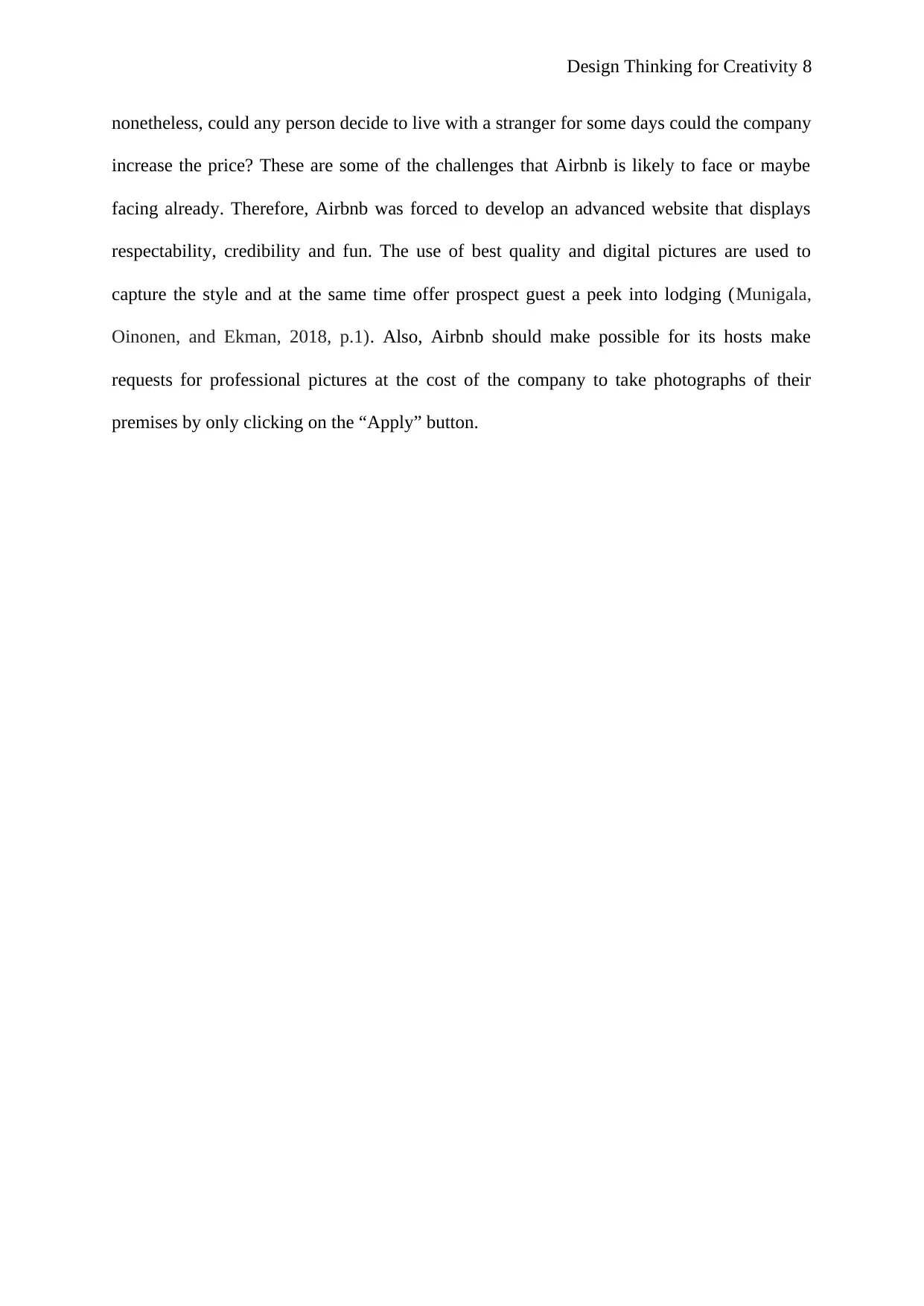
Design Thinking for Creativity 8
nonetheless, could any person decide to live with a stranger for some days could the company
increase the price? These are some of the challenges that Airbnb is likely to face or maybe
facing already. Therefore, Airbnb was forced to develop an advanced website that displays
respectability, credibility and fun. The use of best quality and digital pictures are used to
capture the style and at the same time offer prospect guest a peek into lodging (Munigala,
Oinonen, and Ekman, 2018, p.1). Also, Airbnb should make possible for its hosts make
requests for professional pictures at the cost of the company to take photographs of their
premises by only clicking on the “Apply” button.
nonetheless, could any person decide to live with a stranger for some days could the company
increase the price? These are some of the challenges that Airbnb is likely to face or maybe
facing already. Therefore, Airbnb was forced to develop an advanced website that displays
respectability, credibility and fun. The use of best quality and digital pictures are used to
capture the style and at the same time offer prospect guest a peek into lodging (Munigala,
Oinonen, and Ekman, 2018, p.1). Also, Airbnb should make possible for its hosts make
requests for professional pictures at the cost of the company to take photographs of their
premises by only clicking on the “Apply” button.
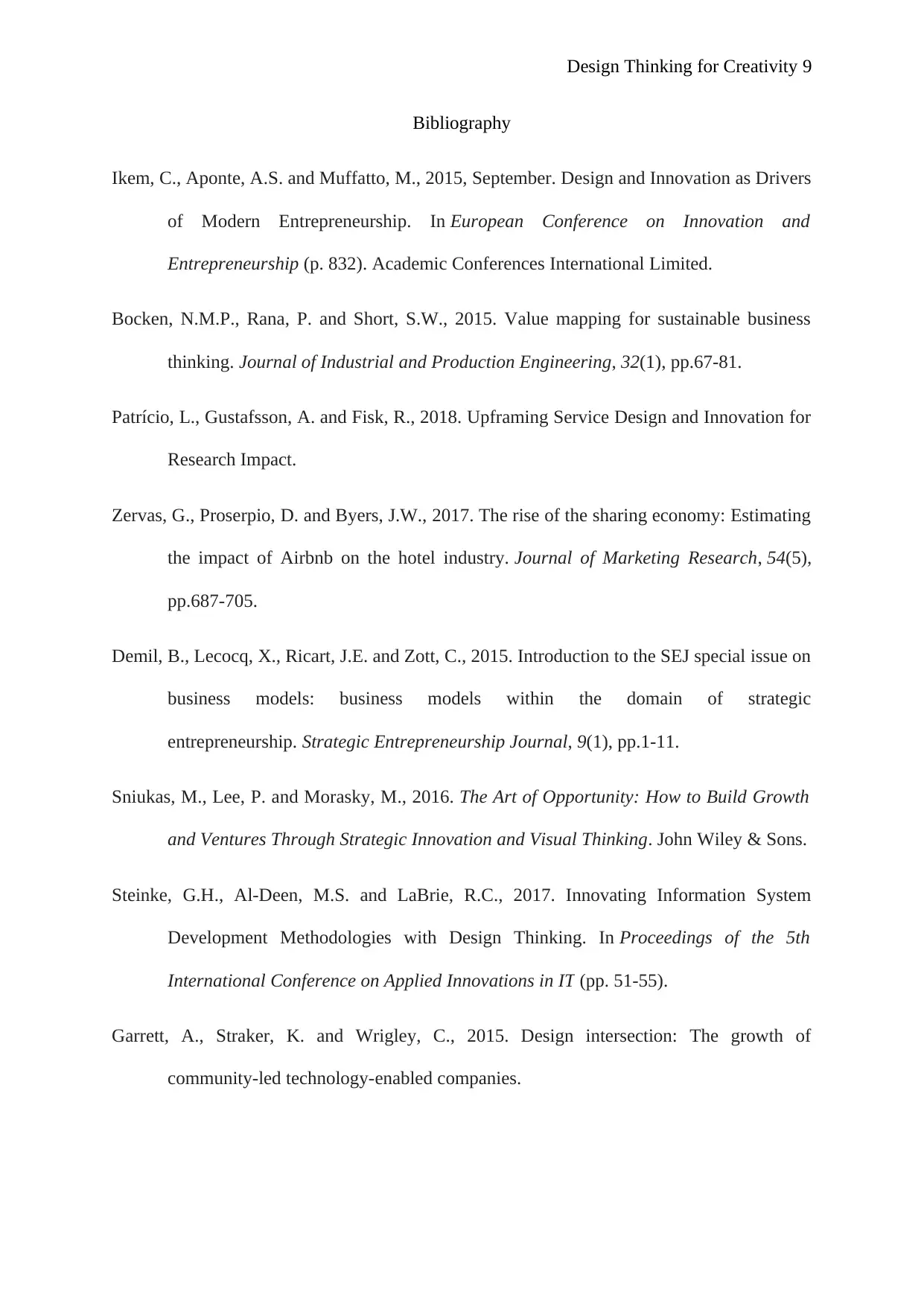
Design Thinking for Creativity 9
Bibliography
Ikem, C., Aponte, A.S. and Muffatto, M., 2015, September. Design and Innovation as Drivers
of Modern Entrepreneurship. In European Conference on Innovation and
Entrepreneurship (p. 832). Academic Conferences International Limited.
Bocken, N.M.P., Rana, P. and Short, S.W., 2015. Value mapping for sustainable business
thinking. Journal of Industrial and Production Engineering, 32(1), pp.67-81.
Patrício, L., Gustafsson, A. and Fisk, R., 2018. Upframing Service Design and Innovation for
Research Impact.
Zervas, G., Proserpio, D. and Byers, J.W., 2017. The rise of the sharing economy: Estimating
the impact of Airbnb on the hotel industry. Journal of Marketing Research, 54(5),
pp.687-705.
Demil, B., Lecocq, X., Ricart, J.E. and Zott, C., 2015. Introduction to the SEJ special issue on
business models: business models within the domain of strategic
entrepreneurship. Strategic Entrepreneurship Journal, 9(1), pp.1-11.
Sniukas, M., Lee, P. and Morasky, M., 2016. The Art of Opportunity: How to Build Growth
and Ventures Through Strategic Innovation and Visual Thinking. John Wiley & Sons.
Steinke, G.H., Al-Deen, M.S. and LaBrie, R.C., 2017. Innovating Information System
Development Methodologies with Design Thinking. In Proceedings of the 5th
International Conference on Applied Innovations in IT (pp. 51-55).
Garrett, A., Straker, K. and Wrigley, C., 2015. Design intersection: The growth of
community-led technology-enabled companies.
Bibliography
Ikem, C., Aponte, A.S. and Muffatto, M., 2015, September. Design and Innovation as Drivers
of Modern Entrepreneurship. In European Conference on Innovation and
Entrepreneurship (p. 832). Academic Conferences International Limited.
Bocken, N.M.P., Rana, P. and Short, S.W., 2015. Value mapping for sustainable business
thinking. Journal of Industrial and Production Engineering, 32(1), pp.67-81.
Patrício, L., Gustafsson, A. and Fisk, R., 2018. Upframing Service Design and Innovation for
Research Impact.
Zervas, G., Proserpio, D. and Byers, J.W., 2017. The rise of the sharing economy: Estimating
the impact of Airbnb on the hotel industry. Journal of Marketing Research, 54(5),
pp.687-705.
Demil, B., Lecocq, X., Ricart, J.E. and Zott, C., 2015. Introduction to the SEJ special issue on
business models: business models within the domain of strategic
entrepreneurship. Strategic Entrepreneurship Journal, 9(1), pp.1-11.
Sniukas, M., Lee, P. and Morasky, M., 2016. The Art of Opportunity: How to Build Growth
and Ventures Through Strategic Innovation and Visual Thinking. John Wiley & Sons.
Steinke, G.H., Al-Deen, M.S. and LaBrie, R.C., 2017. Innovating Information System
Development Methodologies with Design Thinking. In Proceedings of the 5th
International Conference on Applied Innovations in IT (pp. 51-55).
Garrett, A., Straker, K. and Wrigley, C., 2015. Design intersection: The growth of
community-led technology-enabled companies.
⊘ This is a preview!⊘
Do you want full access?
Subscribe today to unlock all pages.

Trusted by 1+ million students worldwide
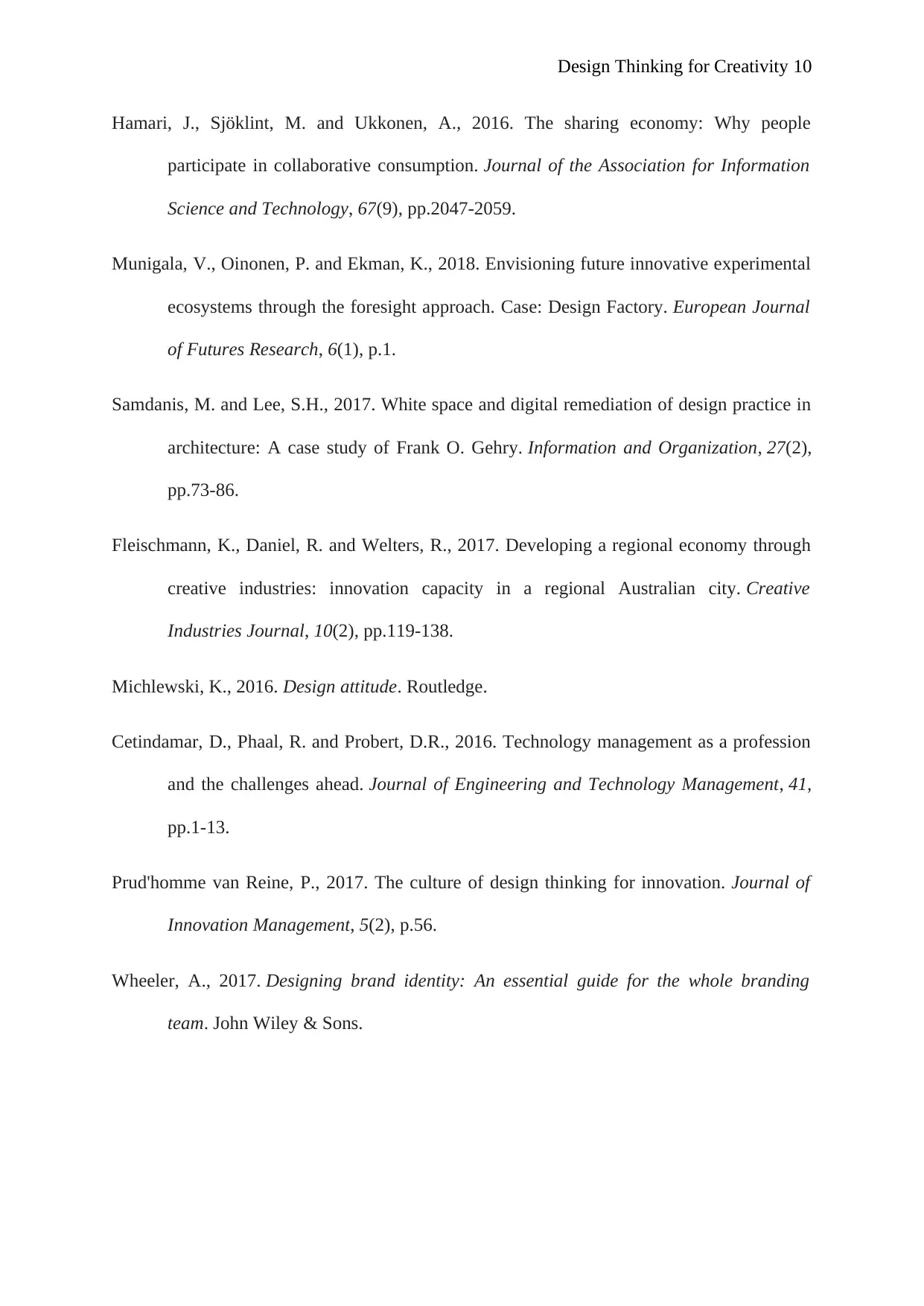
Design Thinking for Creativity 10
Hamari, J., Sjöklint, M. and Ukkonen, A., 2016. The sharing economy: Why people
participate in collaborative consumption. Journal of the Association for Information
Science and Technology, 67(9), pp.2047-2059.
Munigala, V., Oinonen, P. and Ekman, K., 2018. Envisioning future innovative experimental
ecosystems through the foresight approach. Case: Design Factory. European Journal
of Futures Research, 6(1), p.1.
Samdanis, M. and Lee, S.H., 2017. White space and digital remediation of design practice in
architecture: A case study of Frank O. Gehry. Information and Organization, 27(2),
pp.73-86.
Fleischmann, K., Daniel, R. and Welters, R., 2017. Developing a regional economy through
creative industries: innovation capacity in a regional Australian city. Creative
Industries Journal, 10(2), pp.119-138.
Michlewski, K., 2016. Design attitude. Routledge.
Cetindamar, D., Phaal, R. and Probert, D.R., 2016. Technology management as a profession
and the challenges ahead. Journal of Engineering and Technology Management, 41,
pp.1-13.
Prud'homme van Reine, P., 2017. The culture of design thinking for innovation. Journal of
Innovation Management, 5(2), p.56.
Wheeler, A., 2017. Designing brand identity: An essential guide for the whole branding
team. John Wiley & Sons.
Hamari, J., Sjöklint, M. and Ukkonen, A., 2016. The sharing economy: Why people
participate in collaborative consumption. Journal of the Association for Information
Science and Technology, 67(9), pp.2047-2059.
Munigala, V., Oinonen, P. and Ekman, K., 2018. Envisioning future innovative experimental
ecosystems through the foresight approach. Case: Design Factory. European Journal
of Futures Research, 6(1), p.1.
Samdanis, M. and Lee, S.H., 2017. White space and digital remediation of design practice in
architecture: A case study of Frank O. Gehry. Information and Organization, 27(2),
pp.73-86.
Fleischmann, K., Daniel, R. and Welters, R., 2017. Developing a regional economy through
creative industries: innovation capacity in a regional Australian city. Creative
Industries Journal, 10(2), pp.119-138.
Michlewski, K., 2016. Design attitude. Routledge.
Cetindamar, D., Phaal, R. and Probert, D.R., 2016. Technology management as a profession
and the challenges ahead. Journal of Engineering and Technology Management, 41,
pp.1-13.
Prud'homme van Reine, P., 2017. The culture of design thinking for innovation. Journal of
Innovation Management, 5(2), p.56.
Wheeler, A., 2017. Designing brand identity: An essential guide for the whole branding
team. John Wiley & Sons.
Paraphrase This Document
Need a fresh take? Get an instant paraphrase of this document with our AI Paraphraser

Design Thinking for Creativity 11
1 out of 11
Related Documents
Your All-in-One AI-Powered Toolkit for Academic Success.
+13062052269
info@desklib.com
Available 24*7 on WhatsApp / Email
![[object Object]](/_next/static/media/star-bottom.7253800d.svg)
Unlock your academic potential
Copyright © 2020–2025 A2Z Services. All Rights Reserved. Developed and managed by ZUCOL.



